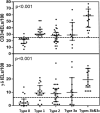A New Intraepithelial γδ T-Lymphocyte Marker for Celiac Disease Classification in Formalin-Fixed Paraffin-Embedded (FFPE) Duodenal Biopsies
- PMID: 33140183
- PMCID: PMC8449760
- DOI: 10.1007/s10620-020-06680-x
A New Intraepithelial γδ T-Lymphocyte Marker for Celiac Disease Classification in Formalin-Fixed Paraffin-Embedded (FFPE) Duodenal Biopsies
Erratum in
-
Correction to: A New Intraepithelial γδ T-Lymphocyte Marker for Celiac Disease Classification in Formalin-Fixed Paraffin-Embedded (FFPE) Duodenal Biopsies.Dig Dis Sci. 2021 Dec;66(12):4572. doi: 10.1007/s10620-020-06731-3. Dig Dis Sci. 2021. PMID: 33236317 Free PMC article. No abstract available.
Abstract
Background: The histopathologic diagnosis of celiac disease (CD) may be challenging when the duodenal biopsies mucosal injury is limited. Intraepithelial T-lymphocytes (IELs) can be useful to characterize the degree of mucosal inflammation. A small fraction of IELs expresses the γδ T-cell receptor (named γδ-IELs), whose density, determined by flow cytometry or frozen section immunohistochemistry (IHC), is a specific marker for CD.
Aim: To establish a new IHC assay for γδ-IELs applicable to formalin-fixed paraffin-embedded (FFPE) duodenal biopsies.
Methods: We analyzed γδ-IELs using IHC in 138 duodenal biopsies using a standard IHC staining protocol with a new monoclonal antibody H-41. IELs were quantitated with digital image analysis.
Results: Compared to those in non-celiac controls (n = 51), γδ-IEL density was significantly increased in newly diagnosed celiac disease patients (n = 22, p < 0.0001). In ROC-curve analysis, the cutoff of 6.5 γδ-IELs/100 enterocytes distinguished optimally active CD patients from non-celiac controls (sensitivity 96%, specificity 95%). γδ-IEL density in CD patients on a gluten-free diet (n = 53) were also higher than in controls (p < 0.0001), but lower than those in newly diagnosed CD (p < 0.0001). The diagnostic value of γδ-IELs outperformed that of CD3 + IELs in both patient groups. γδ-IELs were better than CD3 + IELs distinguishing between celiac disease and conditions histologically mimicking celiac disease (n = 12).
Conclusions: Intraepithelial γδ T-lymphocytes can be stained and quantitated reliably in FFPE duodenal biopsies. The results showed excellent specificity and sensitivity for celiac disease. The new IHC method of detection of γδ-IELs is a promising addition to the routine histopathologic assessment methodology of celiac disease.
Keywords: Autoimmune; Celiac disease; Diagnostics; Histopathology; Inflammation; Lymphocyte; Small bowel.
© 2020. The Author(s).
Conflict of interest statement
None declared.
Figures





Similar articles
-
A new algorithm for coeliac disease based on the 'long forgotten' TCRγδ+ intra-epithelial lymphocytes detected with an antibody working on FFPE sections.Histopathology. 2025 Feb;86(3):397-409. doi: 10.1111/his.15330. Epub 2024 Oct 7. Histopathology. 2025. PMID: 39375308 Free PMC article.
-
Anti-TCR gamma antibody in celiac disease: the value of count on formalin-fixed paraffin-embedded biopsies.Virchows Arch. 2013 Sep;463(3):409-13. doi: 10.1007/s00428-013-1448-7. Epub 2013 Jul 17. Virchows Arch. 2013. PMID: 23860877
-
Immunohistochemistry to Highlight Intraepithelial Lymphocytes in Formalin-Fixed and Frozen Duodenal Biopsies: Comparability of Results and Cut-Off Revision.Dig Dis Sci. 2025 Jul 16. doi: 10.1007/s10620-025-09168-8. Online ahead of print. Dig Dis Sci. 2025. PMID: 40668482
-
Flow cytometry of intestinal intraepithelial lymphocytes in celiac disease.J Immunol Methods. 2011 Jan 5;363(2):177-86. doi: 10.1016/j.jim.2010.09.002. Epub 2010 Sep 15. J Immunol Methods. 2011. PMID: 20833175 Review.
-
Gamma/delta intraepithelial lymphocytes in the mouse small intestine.Anat Sci Int. 2016 Sep;91(4):301-12. doi: 10.1007/s12565-016-0341-2. Epub 2016 Apr 7. Anat Sci Int. 2016. PMID: 27056578 Review.
Cited by
-
Insightful Investigations into the Applications of Immunohistochemistry to Highlight Intraepithelial Lymphocytes in Formalin-Fixed and Frozen Duodenal Biopsies: Comparability of Results and Cut-Off Revision.Dig Dis Sci. 2025 Aug 19. doi: 10.1007/s10620-025-09346-8. Online ahead of print. Dig Dis Sci. 2025. PMID: 40828339 No abstract available.
-
Population-based screening for celiac disease reveals that the majority of patients are undiagnosed and improve on a gluten-free diet.Sci Rep. 2022 Jul 25;12(1):12647. doi: 10.1038/s41598-022-16705-2. Sci Rep. 2022. PMID: 35879335 Free PMC article.
-
A new algorithm for coeliac disease based on the 'long forgotten' TCRγδ+ intra-epithelial lymphocytes detected with an antibody working on FFPE sections.Histopathology. 2025 Feb;86(3):397-409. doi: 10.1111/his.15330. Epub 2024 Oct 7. Histopathology. 2025. PMID: 39375308 Free PMC article.
-
Fit to a "T"-Immunohistochemical Identification of Intra-Epithelial Lymphocytes in Duodenal Biopsies of Patients with Coeliac Disease.Dig Dis Sci. 2025 Aug 11. doi: 10.1007/s10620-025-09316-0. Online ahead of print. Dig Dis Sci. 2025. PMID: 40788373 No abstract available.
-
A feasibility study using quantitative and interpretable histological analyses of celiac disease for automated cell type and tissue area classification.Sci Rep. 2024 Dec 2;14(1):29883. doi: 10.1038/s41598-024-79570-1. Sci Rep. 2024. PMID: 39622903 Free PMC article.
References
Publication types
MeSH terms
Substances
LinkOut - more resources
Full Text Sources
Medical

